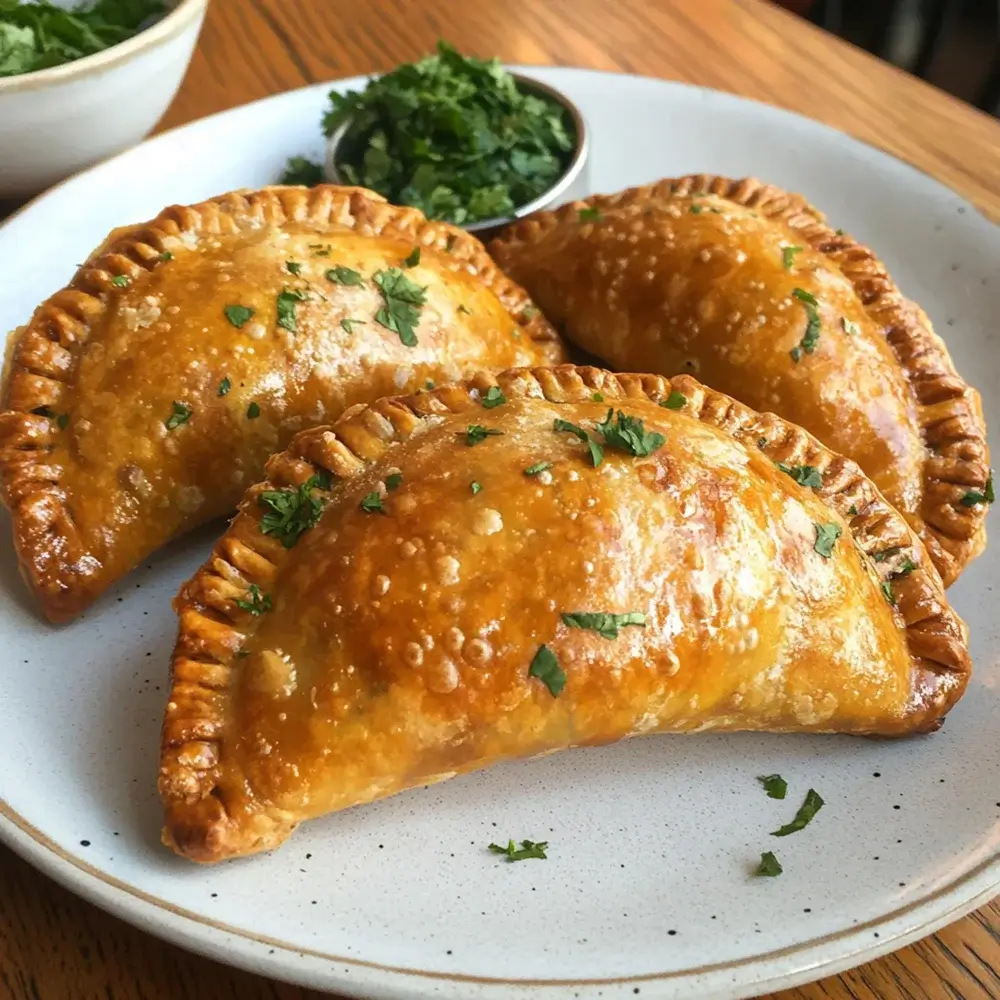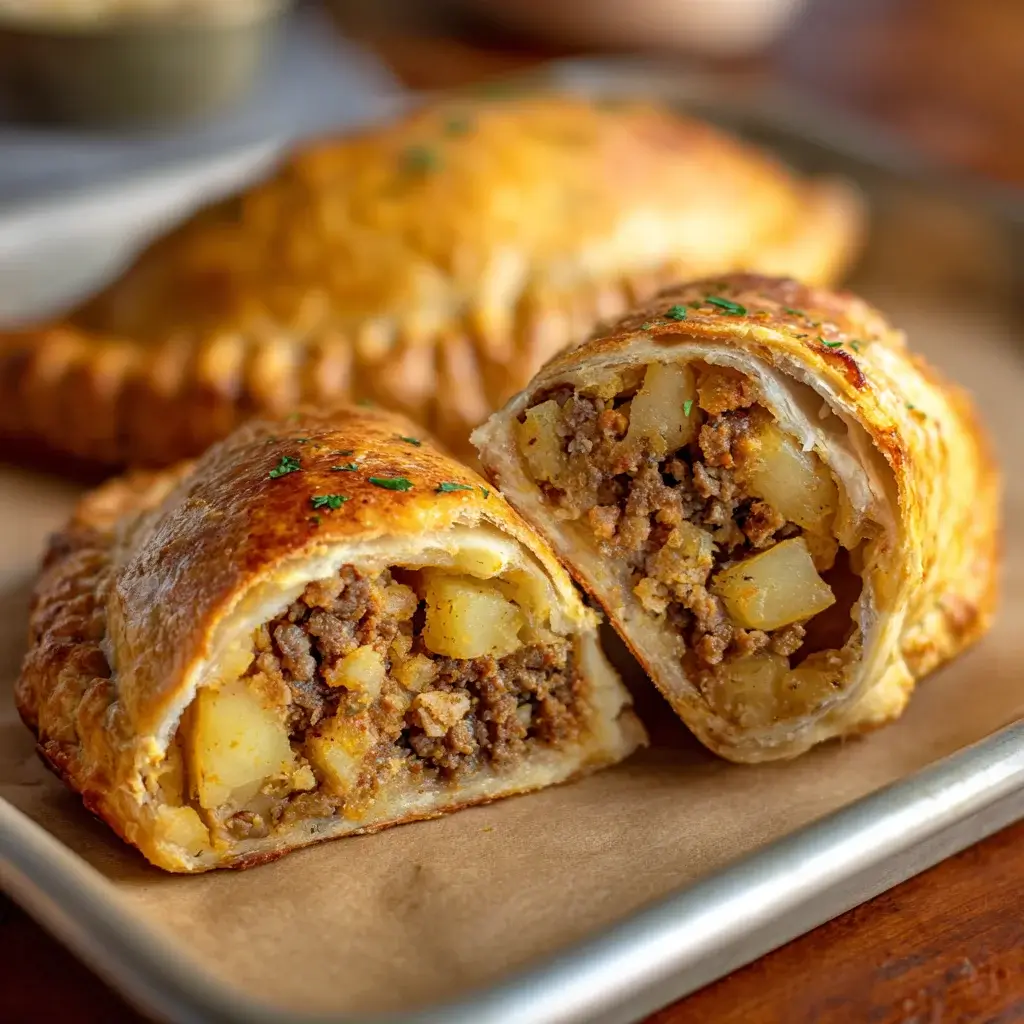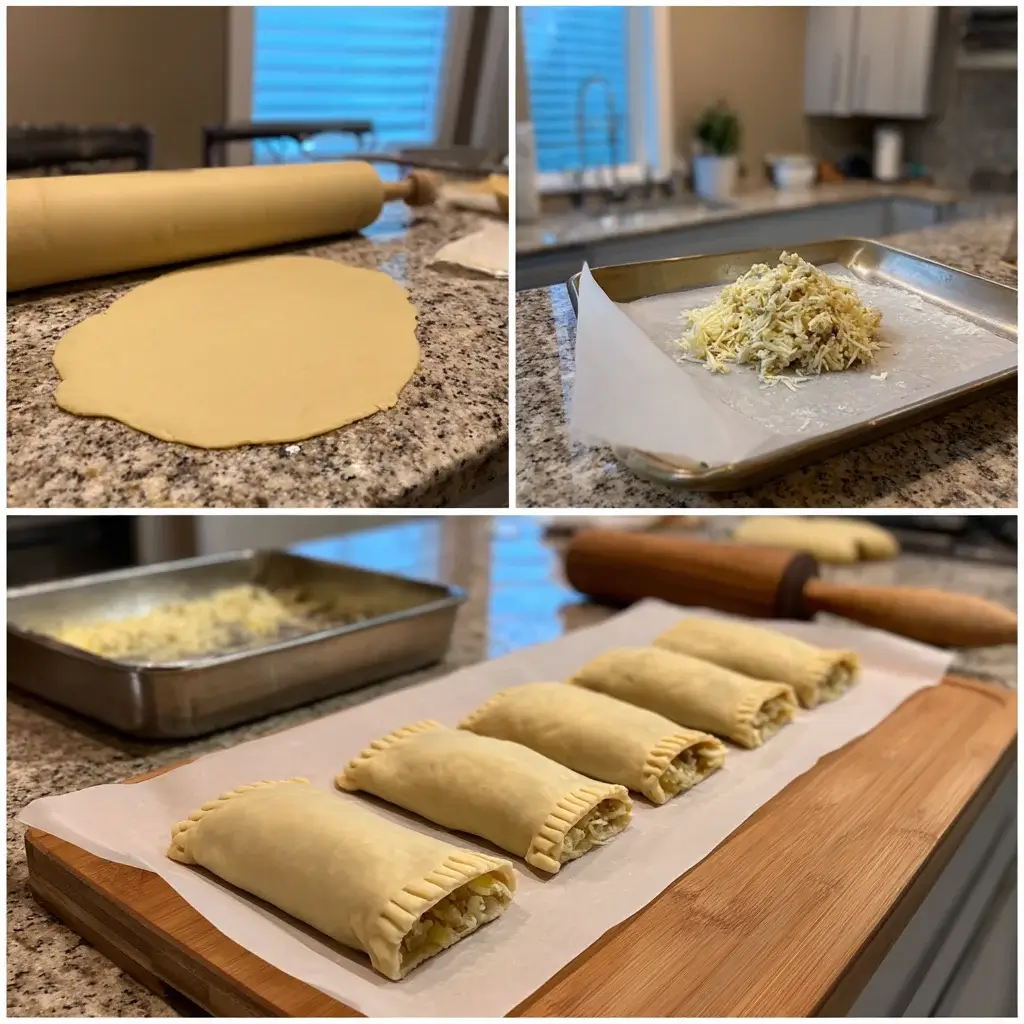
Potato filled pastries are the ultimate comfort food, offering a golden, flaky crust and a savory, flavorful filling. Whether baked, fried, or air-fried, these delightful pastries are enjoyed worldwide, from the traditional Cornish pasty in the UK to the beloved Jewish knish in New York. Chef Amelia is here to guide you through making the perfect potato filled pastry at home. In this guide, she’ll share expert tips, traditional recipes, and global variations that will help you master this irresistible dish.
Table of Contents
Table of Contents
With Amelia’s step-by-step instructions, you’ll learn how to choose the right dough, create a delicious potato filling, and achieve that crispy, tender texture everyone loves. Plus, she’ll show you how to pair your potato filled pastry with her Crispy Salmon Bites made in the air fryer for a well-rounded, protein-packed meal. Ready to dive into the world of potato-filled pastries? Let Amelia help you make the perfect pastry every time!
What Is a Potato Filled Pastry?
A potato filled pastry is any baked or fried dough-based item that’s stuffed with a seasoned potato filling. These pastries may include other ingredients like onions, cheese, herbs, or meats depending on regional preferences. They’re typically handheld, flaky on the outside, and soft on the inside.
What makes them stand out is the balance of textures — crispy pastry shell and creamy, flavorful potato filling. They’re found in bakeries, food stalls, and homemade kitchens alike.
Here’s a quick comparison of popular potato pastry types around the world:
| Type | Origin | Dough Type | Cooking Method | Common Add-Ons |
|---|---|---|---|---|
| Cornish Pasty | England | Shortcrust | Baked | Beef, onion, swede |
| Potato Knish | Jewish (Ashkenazi) | Puff or Dough | Baked/Fried | Onion, garlic |
| Aloo Puff | India | Puff Pastry | Baked | Spices, peas |
| Pierogi | Poland | Pasta-like dough | Boiled/Fried | Cheese, sauerkraut |
Global Popularity & Cultural Significance
potato filled pastry have roots in several food traditions. In the UK, the Cornish pasty was once the go-to lunch for tin miners. It was hearty, portable, and stayed warm for hours. Jewish communities in New York turned the knish into a cultural icon—sold at street carts and diners alike.
Meanwhile, India gave us the aloo puff, a spicy vegetarian version wrapped in buttery layers of puff pastry. Over in Eastern Europe, pierogis and börek filled with mashed potatoes hold a special place on holiday tables.
Their universal appeal lies in their adaptability. These pastries can be spicy or mild, meat-filled or vegan, deep-fried or oven-baked. And with so many options, there’s a potato filled pastry for every palate.
Popular Types of Potato Filled Pastry
British Cornish Pasty
One of the most iconic forms of a potato filled pastry is the Cornish pasty, a handheld pastry packed with diced potatoes, onions, rutabaga (also called swede), and chunks of beef. Its signature crimped edge isn’t just decorative—it was originally designed for miners to hold while eating, discarding the edge afterward to avoid ingesting toxic residue from their hands.

Cornish pasties use a sturdy shortcrust pastry dough that holds up well to hearty fillings. These savory pastries are baked until golden brown, producing a crisp exterior and soft, flavorful interior. Though traditionally filled with beef, vegetarian versions focusing on just potato and veggie fillings are now widely popular.
The potato filled pastry in this context is all about substance. It’s big, satisfying, and designed to keep you full for hours.
Jewish Potato Knish
If there’s one potato filled pastry that symbolizes New York street food, it’s the knish. This Ashkenazi Jewish classic features mashed potatoes encased in either a flaky or dense dough, depending on the regional recipe. They’re usually round or square, baked or fried, and served hot with a side of spicy mustard or sour cream.
A classic knish filling includes mashed potatoes blended with sautéed onions, garlic, and sometimes a bit of schmaltz (chicken fat) for extra richness. Vegan versions skip the animal fat and opt for olive oil or margarine.
Knishes are beloved for their simple yet comforting flavors. Their role in Jewish cuisine spans generations, and today they appear in bakeries, delis, and even gourmet food trucks. You can also make your own at home by wrapping homemade dough or even store-bought puff pastry around a seasoned potato filling.
Comparing Pasty vs. Knish: Which Potato Filled Pastry Wins?
| Feature | Cornish Pasty | Potato Knish |
|---|---|---|
| Dough Type | Shortcrust | Flaky or bread-like |
| Potato Texture | Diced, firm | Mashed, soft |
| Add-Ins | Beef, onion, rutabaga | Onion, garlic, herbs |
| Serving Temp | Warm or room temperature | Best served hot |
| Origin | Cornwall, England | Jewish cuisine, Eastern Europe to NYC |
Both styles showcase the versatility of the potato filled pastry. Whether you prefer a crisp crust or a pillowy dough, these recipes prove that potatoes wrapped in pastry are always a good idea.
Regional Variations Around the World
Indian Aloo Puff and Samosa
In Indian cuisine, the potato filled pastry takes on a spicy personality. The aloo puff is a beloved bakery item made with layers of puff pastry and a masala potato filling. It’s often eaten as a tea-time snack or breakfast item. Inside, you’ll find mashed potatoes mixed with green peas, chili, turmeric, cumin, and coriander—spices that wake up the senses.
Then there’s the iconic samosa. While it isn’t a puff pastry per se, it’s undeniably a pastry filled with potato. Triangular in shape and deep-fried to golden perfection, samosas are crunchy on the outside with a flavorful spiced potato mix inside. Both these pastries use potatoes as the star ingredient, delivering satisfying bites with a regional punch.
India’s versions of the potato filled pastry are hot, flaky, and loaded with flavor—a true reflection of its spice-loving culture.
Eastern European Pierogi and Börek
Moving westward, Eastern Europe presents a more delicate side of the potato filled pastry. Take pierogi, for example—a Polish dumpling-like pastry that’s usually boiled, pan-fried, or baked. It’s typically filled with mashed potatoes and cheese, then served with sour cream or caramelized onions. The dough is soft, pliable, and very different from flaky pastries, but it’s still a stuffed dough—making it a distant cousin in the pastry world.
In Turkey and the Balkans, we find börek. While not always potato-based, a common version includes a mashed potato filling wrapped in layers of ultra-thin phyllo dough. It’s brushed with butter or oil and baked until golden and crispy. Börek is often cut into squares or spirals and served as a breakfast, snack, or lunch item.
These dishes show the diverse techniques used around the world to shape and cook a potato filled pastry, from baking and boiling to frying and folding.
Why Global Variations Matter
Each culture adds its own twist—spices in India, cheese in Poland, or flaky phyllo in Turkey. But the core idea stays the same: a starchy, satisfying filling wrapped in a tender or crisp dough.
Here’s a quick overview:
| Region | Variation | Dough Type | Filling Highlights |
|---|---|---|---|
| India | Aloo Puff, Samosa | Puff/Fried Dough | Spiced mashed potatoes, peas |
| Poland | Pierogi | Dumpling Dough | Potato, cheese |
| Turkey/Balkans | Börek | Phyllo | Mashed potatoes, onions |
Each regional pastry proves that the potato filled pastry is not just a comfort food—it’s a canvas for culture, creativity, and culinary heritage.
Ingredients & Dough Choices for Potato Pastries
Types of Dough Used in Potato Filled Pastries
The dough is the foundation of any potato filled pastry—and choosing the right one makes all the difference in texture and flavor. While many pastry types exist, a few stand out as best suited for wrapping up those creamy potato centers.
1. Shortcrust Pastry
Shortcrust is commonly used in Cornish pasties and other hand pies. It’s firm, crumbly, and holds up well to rich fillings. Perfect for baked potato filled pastries that need structure and portability.
2. Puff Pastry
Flaky and buttery, puff pastry is ideal for lighter, more delicate potato pastries. It puffs up during baking, creating layers that contrast beautifully with soft mashed potatoes. Think of Indian aloo puffs or even modern takes on knishes.
3. Phyllo Dough
Thin and crisp, phyllo is a popular choice in Eastern European and Middle Eastern pastries like börek. Multiple layers surround the filling, giving the potato pastry a flaky bite that shatters in your mouth.
4. Homemade Basic Dough
Some traditional recipes—especially for knishes and pierogis—use a simple mix of flour, water, and oil. This homemade dough is rolled out and filled with mashed potato mixtures, then baked, fried, or boiled.
Here’s a quick comparison chart:
| Dough Type | Texture After Baking | Best For |
|---|---|---|
| Shortcrust | Crumbly, sturdy | Cornish pasties |
| Puff Pastry | Flaky, airy | Aloo puffs, modern knishes |
| Phyllo Dough | Crispy, thin layers | Börek |
| Homemade Dough | Soft, chewy or crisp | Knish, pierogi, samosas |
Best Potato Varieties for Fillings
Not all potatoes behave the same in a potato filled pastry. The variety you choose affects everything from texture to moisture balance.
1. Russet Potatoes
Known for their starchy texture, Russets mash well and absorb flavors beautifully. They’re ideal for classic mashed potato fillings in knishes or pierogi.
2. Yukon Gold
These are slightly waxy and creamy—great for fillings that need more body and less fluff. Use them when you want your potato pastry to have a richer mouthfeel.
3. Red Potatoes
Less starchy and more waxy, red potatoes hold their shape better. They’re ideal for diced potato fillings, like those found in Cornish pasties.
4. Sweet Potatoes
For a twist on the traditional, try sweet potatoes in your filling. They pair well with warm spices, goat cheese, or caramelized onions for a gourmet take on the potato filled pastry.
Step-by-Step Recipe for Classic Potato Filled Pastry
Ingredients & Tools You’ll Need
If you’ve ever wanted to create a warm, flaky potato filled pastry from scratch, this section is your go-to resource. You’ll need just a few pantry staples and a little patience to make the perfect savory treat.
Ingredients (Makes 8 pastries)
| For the Dough | For the Filling |
|---|---|
| 2 ½ cups all-purpose flour | 3 medium Russet potatoes (boiled) |
| 1 tsp salt | 1 small onion (finely diced) |
| 1 cup cold unsalted butter | 2 tbsp olive oil |
| 6–8 tbsp ice water | 1 tsp garlic powder |
| Salt & black pepper to taste | |
| Optional: chopped parsley or shredded cheese |

Tools You’ll Need:
- Mixing bowls
- Rolling pin
- Fork or pastry cutter
- Baking tray
- Parchment paper
Instructions: From Dough to Delicious
Making your own potato filled pastry might sound daunting, but once you get into the rhythm, it’s straightforward—and incredibly satisfying. Here’s the step-by-step breakdown:
Step 1: Make the Dough
- In a large bowl, combine flour and salt.
- Cut cold butter into small cubes and blend into the flour using a pastry cutter or fork until crumbly.
- Gradually add ice water, one tablespoon at a time, mixing until the dough just comes together.
- Form the dough into a ball, wrap in plastic, and refrigerate for at least 30 minutes.
Step 2: Prepare the Filling
- Mash the boiled potatoes until smooth.
- In a skillet, sauté diced onions in olive oil until golden.
- Add garlic powder, salt, pepper, and optional herbs or cheese to the mashed potatoes.
- Mix thoroughly and let the filling cool completely before using.
Step 3: Assemble the Pastries
- Preheat oven to 375°F (190°C). Line a baking tray with parchment paper.
- Divide chilled dough into 8 equal portions.
- Roll each portion into a circle or oval (about ¼ inch thick).
- Place 2–3 tablespoons of the potato filling on one side of each dough round.
- Fold over, seal the edges with a fork, and create small vent slits on top.
Step 4: Bake and Enjoy
- Bake for 25–30 minutes or until golden brown.
- Let cool slightly before serving.
This classic potato filled pastry is flaky, flavorful, and versatile. You can freeze extras before baking or store leftovers in an airtight container for up to 3 days.
Healthier Alternatives and Vegan Options
Vegan Potato Filled Pastry Recipes
You don’t need butter, milk, or eggs to make a delicious potato filled pastry. In fact, many traditional recipes are easily adaptable to fit plant-based lifestyles without compromising on taste or texture.
To make a vegan version of the classic potato filled pastry, start by replacing the butter in your pastry dough with coconut oil or vegan butter. Use plant-based milk for brushing instead of egg wash for a golden crust.
For the filling, mashed potatoes remain the hero. Add olive oil, caramelized onions, garlic, nutritional yeast (for a cheesy flavor), and fresh herbs like parsley or dill. This mixture is not only creamy and satisfying—it’s 100% dairy-free.
Vegan potato filled pastries can be baked, air-fried, or pan-fried, and they pair beautifully with sauces like cashew cream, vegan tzatziki, or spicy chutneys.
Gluten-Free and Baked Alternatives
Health-conscious eaters often ask, “Can I still enjoy a potato filled pastry if I’m avoiding gluten or fried foods?” Absolutely. A few simple swaps can keep the flavors intact while catering to your needs.
Gluten-Free Dough Options:
- Use a blend of gluten-free flours like rice flour, tapioca, and xanthan gum.
- Pre-made gluten-free puff pastry (available in health stores) is a great shortcut.
- Chickpea flour or almond flour can be used for a protein-rich twist.
Baked, Not Fried:
Skip the frying pan and opt for baking. Simply brush your assembled potato filled pastry with a bit of olive oil or plant-based milk and bake at 375°F (190°C) for 25–30 minutes. The result? A crisp, golden shell with less fat and zero mess.
Low-Carb Option:
Swap out the dough entirely for a thin cauliflower or almond flour wrap. These won’t deliver the same flaky texture, but they’re perfect for keto or paleo diets—and still allow you to enjoy a stuffed pastry experience.
Why Healthier Versions Still Deliver Big Flavor
Just because your potato filled pastry is vegan, baked, or gluten-free doesn’t mean it has to be bland. With the right spices, fresh herbs, and flavor pairings, you can make a lighter version that’s even more exciting than the original.
Try mixing in roasted garlic, sautéed mushrooms, or vegan cheese alternatives to elevate the dish. Or explore global variations like samosas and börek that are naturally vegetarian and easy to adapt.
Serving Ideas & Accompaniments
Sauces and Dips That Pair Well with Potato Filled Pastry
A potato filled pastry is already satisfying on its own, but the right dipping sauce can elevate it into something unforgettable. Whether you’re serving it at brunch, dinner, or as a party snack, sauces bring contrast and flavor.

Here are crowd-pleasing sauces to serve with any potato filled pastry:
| Sauce Type | Best Pairing |
|---|---|
| Spicy Chutney | Indian-style aloo puffs or samosas |
| Garlic Aioli | Baked puff pastries or vegan versions |
| Sour Cream + Chives | Knishes and savory baked pastries |
| Herb Yogurt Dip | Börek or Middle Eastern potato pastries |
| Mustard Sauce | Cornish pasties and other rustic-style pastries |
These dipping options not only balance the richness of a potato filled pastry, but they also add a cultural flair. For example, chutneys bring tangy heat, while sour cream provides cool contrast.
How to Serve Potato Filled Pastries for Every Occasion
1. Brunch Boards
Create a brunch spread with mini potato filled pastries, hard-boiled eggs, pickled veggies, and fresh fruit. Serve with a side of hot tea or coffee for a cozy weekend vibe.
2. Appetizer Platters
Turn your pastries into finger foods. Cut them into halves or quarters, add toothpicks, and arrange on a tray with dips in the center.
3. Dinner Entrée
Make a meal out of it. Serve two warm potato filled pastries with a fresh side salad, sautéed greens, or a hearty soup like lentil or tomato bisque.
4. On-the-Go Lunch
The beauty of a good potato filled pastry is that it travels well. Wrap one in parchment paper for a delicious, mess-free lunch at work or school.
Table: Serving Style Ideas
| Occasion | Serving Style | Pairing Suggestions |
|---|---|---|
| Brunch | Mini pastries, tea, fresh fruit | Yogurt dip, jam, mild chutney |
| Party Platter | Bite-sized portions, mixed dips | Aioli, chutney, sour cream |
| Family Dinner | Full-size pastries, side salad | Roasted veggies, soup |
| Picnic or Lunch | Wrapped pastry with dipping container | Mustard dip, hot sauce |
With all these ideas, your potato filled pastry won’t just taste great—it’ll look stunning, too.
Storing and Reheating Potato Pastries
Best Storage Practices for Potato Filled Pastry
When you’ve made a big batch of potato filled pastries, proper storage ensures they stay fresh and delicious for days. Whether you’re meal prepping or saving leftovers, here’s how to keep them tasting as good as the day they were baked.
Room Temperature (Short-Term):
If you plan to eat your potato filled pastry within 24 hours, you can store it at room temperature in an airtight container or wrapped in parchment paper. Avoid plastic wrap—it can make the crust soggy.
Refrigerator (Mid-Term):
For storage up to 3–4 days, place cooled potato filled pastries in a sealed container and refrigerate. Layer parchment between stacked pastries to prevent sticking.
Freezer (Long-Term):
To keep them for weeks, freeze your baked or unbaked potato filled pastry individually. Wrap each in foil or freezer paper, then place in a ziplock bag. They’ll last up to 3 months.
Reheating Potato Filled Pastry Without Losing Texture
The biggest concern when reheating a potato filled pastry is texture. You want that crisp outer shell and creamy interior—not a soggy, rubbery mess. Here’s how to do it right:
Oven Method (Best Overall):
- Preheat oven to 350°F (175°C).
- Place pastries on a baking sheet lined with parchment.
- Heat for 10–15 minutes (20 if frozen) until heated through and the crust is crispy.
Air Fryer (Quick & Crisp):
Reheat one or two potato filled pastries in an air fryer at 350°F for 5–7 minutes. This keeps the pastry flaky and prevents it from drying out.
Microwave (Last Resort):
Only use the microwave if you’re in a rush. Place the potato filled pastry on a plate with a damp paper towel over it and heat for 30–45 seconds. Be warned: it’ll be soft, not crisp.
Pro Tips for Make-Ahead Potato Pastry Batches
- Pre-bake and freeze: Make a large batch of potato filled pastries, bake them halfway, then freeze. Finish baking just before serving.
- Label and date your frozen pastries to avoid freezer burn or waste.
- Don’t overstuff: This prevents leaks during freezing or reheating.
Common Mistakes and Troubleshooting Potato Filled Pastries
Why Your Potato Filled Pastry Might Be Soggy
There’s nothing more disappointing than biting into a soggy potato filled pastry. Moisture is usually the culprit—and it comes from either the filling or poor baking technique.
How to Fix It:
- Always cool your filling before sealing it in the dough. Hot fillings cause condensation inside the potato filled pastry, ruining the texture.
- Bake on a preheated sheet or use a pizza stone to crisp the bottom.
- Avoid watery ingredients like fresh tomatoes or high-moisture cheeses in your potato filled pastry.
If you’re freezing pastries, avoid sealing in steam. Let them cool fully before wrapping.
When the Pastry Crust Is Too Hard or Dry
Too much flour or overbaking can lead to a hard, unpleasant crust. This issue often comes up in homemade versions of the potato filled pastry, especially when doughs aren’t balanced.
How to Fix It:
- Use a kitchen scale to measure flour accurately—adding even ¼ cup extra can ruin the dough.
- Brush the top of the potato filled pastry with plant-based milk or egg wash before baking to maintain moisture and color.
- Don’t overbake. Pull pastries when they’re golden, not brown.
Filling Problems: Too Dry, Too Wet, or Lacking Flavor
The heart of a potato filled pastry is the filling—and a bland or dry filling ruins the whole bite.
Fixes for Each Problem:
- Too dry: Add sautéed onions, a splash of broth, or olive oil to moisten mashed potatoes.
- Too wet: Simmer off excess moisture in the skillet before stuffing.
- No flavor: Season boldly! Garlic, black pepper, paprika, or even curry powder make a big difference.
Every great potato filled pastry should hit you with flavor and balance—creamy potatoes, well-seasoned base, and a flaky outer layer.
Cracks and Leaks in the Pastry
Your potato filled pastry might crack during baking if the dough is too dry or stretched too thin. Another common mistake is overfilling, which causes tears and leakage.
Solutions:
- Patch small tears with extra dough before baking.
- Don’t overwork the dough; let it rest to avoid elasticity issues.
- Roll your dough to a consistent thickness (about ¼ inch) for strength and flakiness.
Final Troubleshooting Table
| Problem | Likely Cause | Solution |
|---|---|---|
| Soggy bottom | Filling too hot or wet | Cool filling; preheat tray |
| Crust too hard | Too much flour or overbaking | Use exact measurements; reduce bake time |
| Filling lacks flavor | Underspiced or too basic | Add herbs, spices, sautéed veggies |
| Dough tearing or leaking | Overfilled or over-stretched dough | Use less filling; roll evenly |
| Pastry splits in freezer | Not cooled before freezing | Let pastries fully cool pre-freeze |
Now that you’re armed with solutions, your next potato filled pastry batch should be golden, crisp, and utterly irresistible.
Whether you prefer them flaky or chewy, baked or fried, spicy or mild—the potato filled pastry is a time-tested comfort food that adapts to every culture, occasion, and dietary style. From the hearty Cornish pasty and savory knish to the spiced samosa and phyllo-wrapped börek, there’s a world of flavor inside that pastry shell.
These stuffed delights aren’t just convenient—they’re incredibly satisfying, budget-friendly, and endlessly customizable. With the step-by-step recipe, global variations, storage tips, and troubleshooting advice covered in this guide, you’re ready to make the perfect potato filled pastry from scratch.
Let’s stay connected! Follow me on Pinterest and YouTube for more delicious sweet and savory recipes. Have a question? Ask in the comments or contact us, and I’ll be happy to help! 🤗 With love, Amelia!
Frequently Asked Questions About Potato Filled Pastry
What is a potato pasty called?
A potato pasty is traditionally known as a Cornish pasty in the UK. It’s a type of potato filled pastry that also includes diced beef, onion, and rutabaga (swede), all encased in shortcrust dough and baked until golden. The Cornish pasty has Protected Geographical Indication (PGI) status, meaning only those made in Cornwall using traditional methods can legally carry the name.
What is a potato filled pastry that starts with K?
That would be the knish—a well-known Jewish potato filled pastry. Originating from Eastern Europe and made famous in New York, knishes are usually round or square, with a filling of mashed potatoes wrapped in flaky or doughy crust. They’re baked or fried and often served with mustard or sour cream.
What is a potato knish?
A potato knish is a traditional Ashkenazi Jewish potato filled pastry consisting of a soft or flaky crust encasing a savory mashed potato filling. Some versions include caramelized onions, garlic, or herbs. Knishes can be baked or fried and are typically enjoyed warm as a snack or side dish.
What are the 4 types of pastry?
The four main types of pastry used in cooking and baking—including many potato filled pastry recipes—are:
Shortcrust pastry – sturdy and crumbly, used in pies and pasties
Puff pastry – light and flaky, often used in aloo puffs or modern knishes
Choux pastry – used for desserts like éclairs, not typical for potato fillings
Filo pastry – very thin and crispy, ideal for börek-style potato filled pastries
